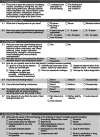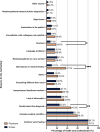Prevalence and characteristics of the 'bad feeling' among healthcare professionals in the context of emergency situations: A Bi-Hospital Survey
- PMID: 39010304
- PMCID: PMC11740282
- DOI: 10.1111/jocn.17374
Prevalence and characteristics of the 'bad feeling' among healthcare professionals in the context of emergency situations: A Bi-Hospital Survey
Abstract
Introduction: Clinical decision-making is based on objective and subjective criteria, including healthcare workers impressions and feelings. This research examines the perception and implications of a 'bad feeling' experienced by healthcare professionals, focusing on its prevalence and characteristics.
Methods: A cross-sectional paper-based survey was conducted from January to July 2023 at the University Medicine Greifswald and the hospital Sömmerda involving physicians, nurses, medical students and trainees from various specialties. With ethics committee approval, participants were recruited and surveyed at regular clinical events. Data analysis was performed using SPSS® Statistics. The manuscript was written using the Strobe checklist.
Results: Out of 250 questionnaires distributed, 217 were valid for analysis after a 94.9% return rate and subsequent exclusions. Sixty-five per cent of respondents experience the 'bad feeling' occasionally to frequently. There was a significant positive correlation between the frequency of 'bad feeling' and work experience. The predominant cause of this feeling was identified as intuition, reported by 79.8% of participants, with 80% finding it often helpful in their clinical judgement. Notably, in 16.1% of cases, the 'bad feeling' escalated in the further clinical course into an actual emergency. Furthermore, 60% of respondents indicated that this feeling occasionally or often serves as an early indicator of a potential, yet unrecognised, emergency in patient care.
Conclusions: This study demonstrates the relevance of clinical experience to decision-making. As an expression of this, there is a correlation between the frequency of a 'bad feeling' and the number of years of experience. It is recommended that the 'bad feeling' be deliberately acknowledged and reinforced as an early warning signal for emergency situations, given its significant implications for patient safety. Future initiatives could include advanced training and research, as well as tools such as pocket maps, to better equip healthcare professionals in responding to this intuition.
Keywords: clinical decision‐making; early warning signals; emergency situations; healthcare professionals; intuition; patient care; patient safety.
© 2024 The Author(s). Journal of Clinical Nursing published by John Wiley & Sons Ltd.
Conflict of interest statement
The authors declare that they have no known competing financial interests or personal relationships that could have appeared to influence the work reported in this paper.
Figures



Similar articles
-
Towards an empirically based validation of intuitive diagnostic: Rümke's 'praecox feeling' across the schizophrenia spectrum: preliminary results.Psychopathology. 2006;39(5):209-17. doi: 10.1159/000093921. Epub 2006 Jun 14. Psychopathology. 2006. PMID: 16778451
-
Cross-cultural validation and psychometric testing of the French version of the TeamSTEPPS teamwork perceptions questionnaire.J Health Organ Manag. 2024 Aug 29;38(6):923-941. doi: 10.1108/JHOM-01-2023-0004. J Health Organ Manag. 2024. PMID: 39198954
-
Cross-referencing French hematology teams' knowledge and perception of end-of-life situations: a national mixed-methods survey.BMC Palliat Care. 2025 Jan 31;24(1):32. doi: 10.1186/s12904-025-01659-9. BMC Palliat Care. 2025. PMID: 39891179 Free PMC article.
-
The effects of interactive training of healthcare providers on the management of life-threatening emergencies in hospital.Cochrane Database Syst Rev. 2019 Sep 24;9(9):CD012177. doi: 10.1002/14651858.CD012177.pub2. Cochrane Database Syst Rev. 2019. PMID: 31549741 Free PMC article.
-
Psychological interventions to foster resilience in healthcare professionals.Cochrane Database Syst Rev. 2020 Jul 5;7(7):CD012527. doi: 10.1002/14651858.CD012527.pub2. Cochrane Database Syst Rev. 2020. PMID: 32627860 Free PMC article.
References
-
- Bagshaw, S. M. , Mondor, E. E. , Scouten, C. , Montgomery, C. , Slater‐MacLean, L. , Jones, D. A. , Bellomo, R. , Noel Gibney, R. T. , & for the Capital Health Medical Emergency Team Investigators . (2010). A survey of nurses' beliefs about the medical emergency team system in a Canadian tertiary hospital. American Journal of Critical Care, 19(1), 74–83. - PubMed
-
- Beglinger, B. , Rohacek, M. , Ackermann, S. , Hertwig, R. , Karakoumis‐Ilsemann, J. , Boutellier, S. , Geigy, N. , Nickel, C. , & Bingisser, R. (2015). Physician's first clinical impression of emergency department patients with nonspecific complaints is associated with morbidity and mortality. Medicine, 94, e374. - PMC - PubMed
-
- Bingham, G. , Fossum, M. , Barratt, M. , & Bucknall, T. K. (2015). Clinical review criteria and medical emergency teams: Evaluating a two‐tier rapid response system. Critical Care and Resuscitation, 17(3), 167–173. - PubMed
-
- Boyd, J. M. , Wu, G. , & Stelfox, H. T. (2017). The impact of checklists on inpatient safety outcomes: A systematic review of randomized controlled trials. Journal of Hospital Medicine, 12(8), 675–682. - PubMed
MeSH terms
LinkOut - more resources
Full Text Sources
Research Materials

